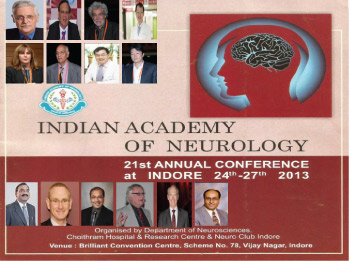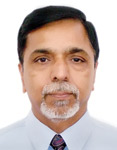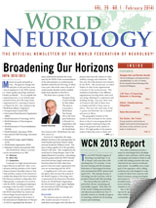By Man Mohan Mehndiratta, MD, DM (Neurology), FAMS, FRCP

Figure 1. International speakers on the occasion of IAN Conference Oct. 24-27, 2013: Upper panel from left to right are Robert H. Brown (USA), Marco T. Medina (Honduras), Olivier Dulac (France), Shuu Jiun Wang (Taiwan), Page B. Pennell (U.S.), Shri K. Mishra (U.S.), Beom S. Jeon (South Korea) and Keun Hwa Jung (South Korea). Lower panel from left to right are Vijay Sharma (Singapore), Barry Snow (New Zealand), Neeraj Kumar (U.S.), Martin J. Brodie (Scotland), William Carroll (Australia) and Bhupendra O. Khatri (U.S.).
The Indian Academy of Neurology (IAN), with its primary objective of imparting education, coordinates various activities that support and supplement formal neurology education. It has been instrumental in organizing various national and international conferences, workshops and Continuing Medical Education (CME) programs with national and international outreach programs1.
Professor Marco T. Medina, professor of Neurology from Honduras was one of the faculty invited as part of this outreach program. Other invited international faculty members were Beom S. Jeon, vice president of the Asian Oceanian Association of Neurology; William Carroll, vice president of the World Federation of Neurology; Robert H. Brown, president of the American Neurological Association; Shri K. Mishra; Bhupendra O. Khatri; Neeraj Kumar and Page Pennel; J. D. Khandekar (USA); Barry Snow; Olivier Dulac and Martin Brodie. (See Figure 1.) These academic outreach programs foster critical and analytical thinking, professional and experiential learning and promotes research2,3. It has an advocacy subsection convened by Man Mohan Mehndiratta and ably assisted by other committed members of IAN — Apoorva Pauranik and Lakshmi Narsimhan. It had been their sincere endeavor to improve the status of public awareness, education and care in India. This subsection organizes workshops to train the members in skills, organizes the neurology quiz, neurology education courses, public awareness and education series, CMEs and camps. Hence, it streamlines and disseminates authentic and comprehensive outreach public health education.
Like every year, the 21st Annual Conference of Indian Academy of Neurology, the IANCON2013, was held at Indore Oct. 24-27, 2013. It was hosted and organized by the Department of Neurosciences, ChoithramHospital and Research Centre and Neuro Club Indore. The conference featured the major breakthroughs and developments in the field of neurology — from clinical practice to research and technology and was attended by renowned national and international faculty and approximately 1,000 delegates. It included a highly informative and interesting scientific program starting with CME on neurological manifestations of systemic diseases, which addressed a wide range of conditions such as nutritional deficiencies, SLE and antiphospholipid antibody syndrome, liver disease, pregnancy, lymphoma and leukemia and small vessel disease. This was followed by symposia and seminars. The theme of one of the symposia was neurotechnology and e-learning, which was chaired by Mehndiratta and Medina from Honduras. Both technical and clinical perspectives regarding the benefits, challenges and limiting factors of developing robotics in neurorehabilitation were discussed. The integration of e-learning in traditional learning was emphasized.

Man Mohan Mehndiratta
Four orations were presented and the Presidential Oration was delivered by Mehndiratta. His presentation was titled “My Journey Through Indian Academy of Neurology and Academy’s Past, Present and Future.” He portrayed the establishment of the IAN, his 14 years of journey in the academy, growth of IAN in terms of academic activities such as conferences, public education and awareness programs and official publications both online (website) and offline (newsletter, reviews in Neurology, Journal- Annals of Indian Academy of Neurology). According to his foresight, the way forward for IAN includes collaboration and synergy, young talent recognition and continental and intercontinental outreach.
William Carroll, vice president of World Federation of Neurology, also graced the occasion and presented his oration on demyelinating diseases and challenges. Another interesting symposium focused on the diagnosis and management of cerebrovascular and neuromuscular diseases using point of care neurosonology.
For the first time in the history of IAN, an Asian and Oceanian Association of Neurology (AOAN) symposium was held in which one of the speakers was Beom S. Jeon, vice president of AOAN from South Korea. He provided valuable insight into how genetic disorders present in dystonia. He also participated in the workshop on videos in clinical neurology. To encourage young neurologists, a paper presentation competition was held, and first, second and third positions were awarded.
A high point of this conference like earlier years was clinicopathological conference (CPC) on a case of fever, rapidly progress altered sensorium, raised intracranial pressure and seizures. The clinical discussant suggested the possiblity of Balamuthia granulomatous amebic encephalitis (GAE) and was confirmed as Balamuthia mandrillaris encephalitis on histopathology.
In the executive committee meeting, Robert H. Brown, president of the American Neurological Association (ANA) was invited to discuss the logistics to foster collaboration of ANA and IAN, which would be really helpful in achieving intercontinental educational outreach.
Looking ahead, IAN will continue to support the neurologists through its key functions, mentor young neurologists and provide opportunities for research. It will continue to develop more outreach initiatives to prepare students and practicing neurologists for academic excellence1.
Mehndiratta is the director, professor and department head, Department of Neurology, JanakpuriSuperspecialityHospital, New Delhi-110058. He may be contacted at mmehndi@hotmail.com.
References
- IndianAcademy of Neurology. Available at http://www.ian.net.in/index.html. Assessed on Nov. 8, 2013
- O’Brien MA, Rogers S, Jamtvedt G, Oxman AD, Odgaard-Jensen J, Kristoffersen DT, Forsetlund L, Bainbridge D, Freemantle N, Davis DA, Haynes RB, Harvey EL Educational outreach visits: effects on professional practice and health care outcomes. Cochrane Database Syst Rev. 2007 Oct 17;(4)
- Forsetlund L, Bjørndal A, Rashidian A, Jamtvedt G, O’Brien MA, Wolf F, Davis D, Odgaard-Jensen J, Oxman AD.Continuing education meetings and workshops: effects on professional practice and health care outcomes. Cochrane Database Syst Rev. 2009 Apr 15;(2)
